Introduction
Welcome to our comprehensive guide designed specifically for beginners venturing into the world of Scrum projects. Scrum, a subset of Agile, is a powerful framework that’s predominantly used in software development but has also found its place in various other industries.
It promotes collaboration, flexibility, and transparency, making it an effective tool for managing complex projects. In this blog post, we’ll break down the key concepts, scrum roles, ceremonies, and artifacts of Scrum, simplifying them for easy comprehension.
Whether you’re a project manager, a team member, or someone simply interested in learn Scrum, this guide will provide you with the essential knowledge you need to navigate your way in a Scrum environment.
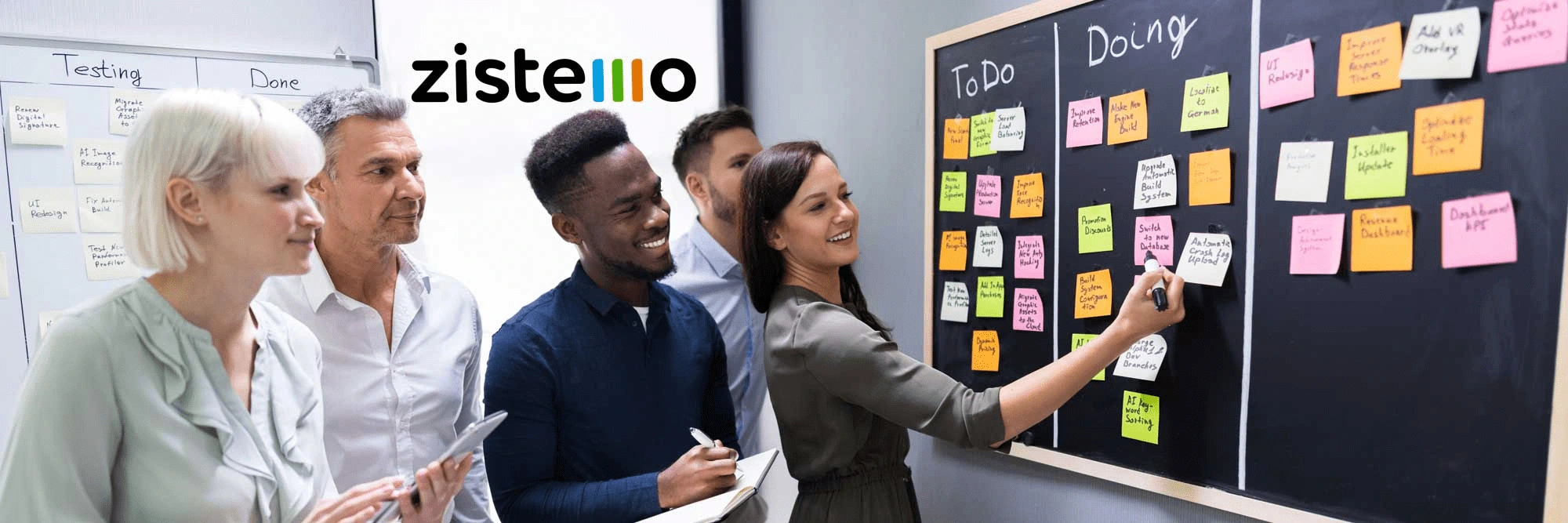
Enhance your project management with Scrum: select zistemo for maximum efficiency and effectiveness.
What is Scrum project management and why should you use it for your next project
Scrum project management is a framework used to managing projects that empowers scrum teams to work efficiently and effectively. Each project is broken up into smaller sections called “sprints,” with scrum teams working together to complete them and move on to the next one.
Zistemo, a leading project time tracking software, uses scrum methodology to streamline team collaboration and communication.
Scrum allows for ongoing feedback and input, resulting in a faster and more efficient development process. By using Scrum project management, you can improve communication within your entire scrum team, streamline workflow processes, and ultimately deliver a better end product.
Whether you’re managing a small team or a large project, Scrum is worth considering.

Use the power of agility with zistemo: Agile project management for effective collaboration and customer satisfaction.
How to build effective scrum teams to successfully complete projects
With the increasing complexity of projects in today’s fast-paced business environment, proper management has become an essential component of success. One effective methodology implemented by many organizations is the Scrum framework.
However, simply adopting the framework is not enough. To create effective Scrum teams to successfully complete projects, proper communication is key. Team members should be able to communicate effectively with not only each other but also with stakeholders and the product owner.
Technology is also a major player in this aspect, and a tool like zistemo can alleviate communication barriers. By fostering open communication and utilizing helpful tools, a Scrum team can ensure project success and deliver quality results.

leashing the Potential of Scrum: Agile Project Management in zistemo.
Breaking down the steps of a Scrum project into iterative sprints
For any agile project management methodology, breaking down a project into smaller achievable sections is crucial. This is where the Scrum framework comes in, and the methodology is often used by project managers to achieve this goal.
zistemo, offers Scrum project management capabilities where teams can plan and execute their projects by breaking them down into iterative sprints. This ensures that teams are not overwhelmed by the immensity of a project, and each team member has a set of responsibilities that are achievable within a certain time frame.
Iterative development sprints in a Scrum project framework allow teams to constantly re-evaluate and fine-tune their approach, leading to a more efficient and streamlined execution of the project.
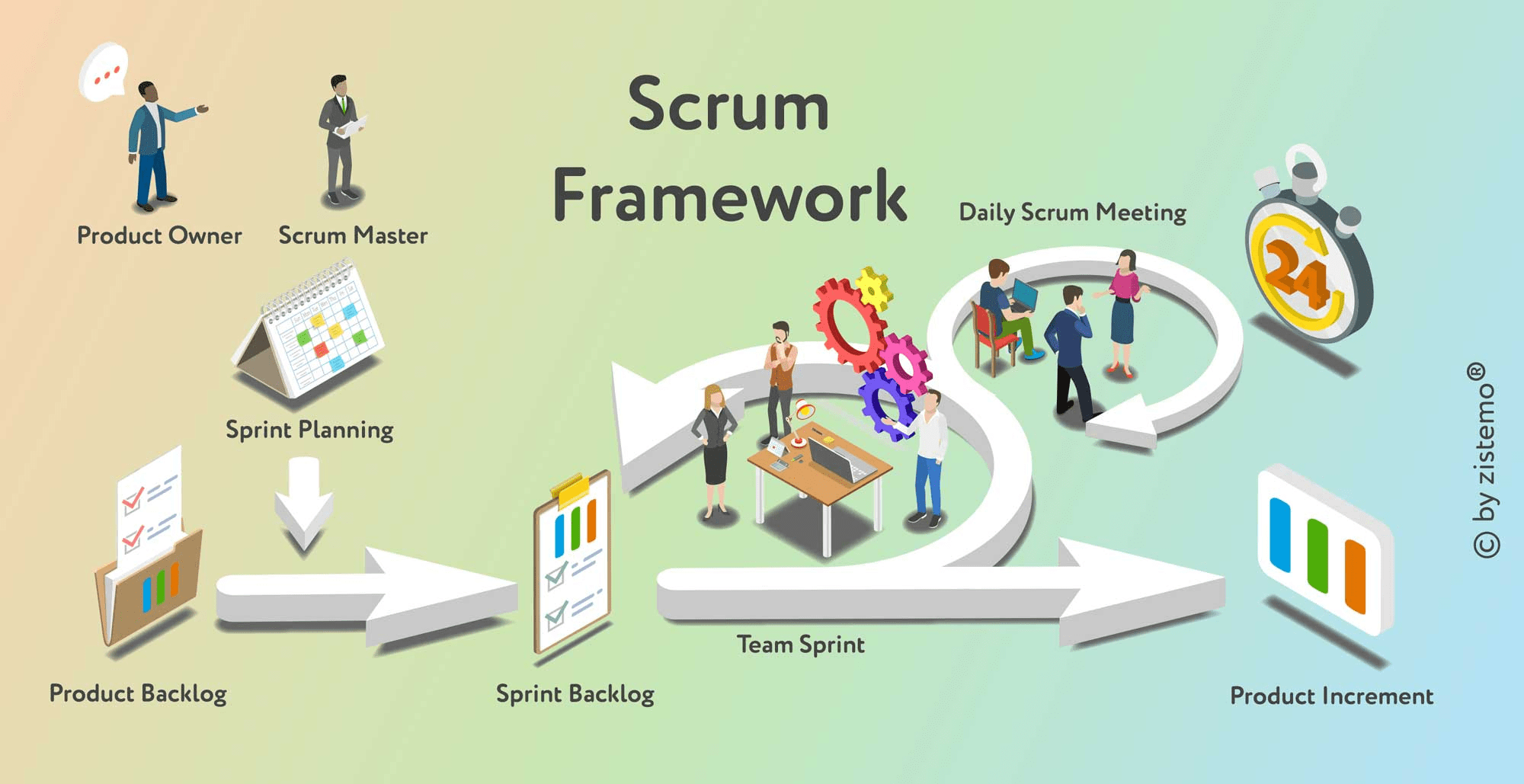
Master the Scrum framework with zistemo: The art of dividing and managing effectively.
The importance of maintaining communication between team members and stakeholders
In order to ensure the success of any project, effective communication among team members and stakeholders is crucial. By sharing information and ideas, everyone involved can work together towards a common goal and avoid misunderstandings or delays.
This is especially important when implementing management tools such as scrum, where a scrum development team or an engineering team must work closely together to meet their goals. Additionally, keeping open lines of communication with customers and other stakeholders allows for productive feedback and ensures that the whole team is on the same page.
This collaborative approach is guided by the Scrum values of commitment, courage, focus, openness, and respect. At zistemo, we believe that communication is at the heart of successful project management and strive to maintain transparent and timely communication with all parties involved.
Understanding the Concept of a Sprint Backlog
A sprint backlog is an essential component of the Agile methodology for software development. It’s the list of tasks that the development team needs to complete during a sprint, which is typically a two-week period. The sprint backlog is derived from the product backlog, a list of all the features, functionalities, and tasks that need to be implemented in the software.
After the sprint is over, the entire team together holds a sprint review to discuss what they accomplished on the previous sprint and what they need to work on during the next sprint. The next is initiated by sprint planning meeting, where the entire team together decides in a sprint planning session what tasks to include in the upcoming sprint backlog.
With the help of powerful tools like zistemo, the entire team can efficiently manage and track their sprint backlogs and sprint goals, ensuring that they are always on track to deliver high-quality software on time.
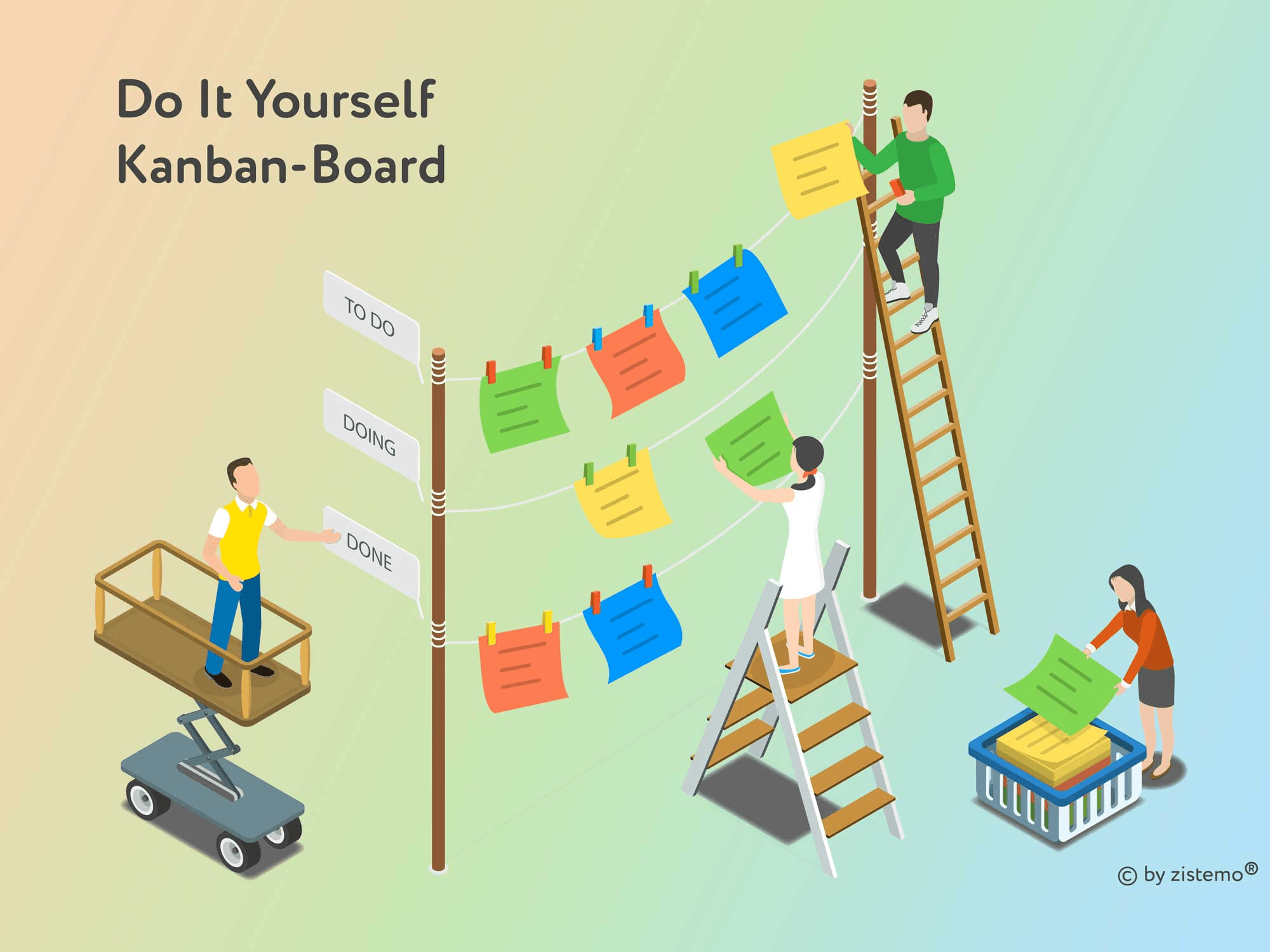
Do It Yourself Kanban-Board
Understanding the fundamentals of scrum meetings
If you’re part of an agile team that uses the Agile methodology to manage projects, you’ve probably heard of scrum meetings. But what exactly is a scrum meeting and how does it work? Essentially, a scrum meeting is a daily check-in where scrum team members discuss their progress, obstacles, and plans for the day.
These daily stand-up meetings are usually short and sweet - no longer than 15 minutes. However, they can be incredibly valuable in keeping the scrum team aligned and on track. Additionally, there are other important aspects of the Agile framework that come into play during a scrum meeting, such as backlog refinement and sprint planning session.
Fortunately, tools like zistemo make it easy to track and manage these tasks, so your scrum team can focus on what really matters - delivering great work.
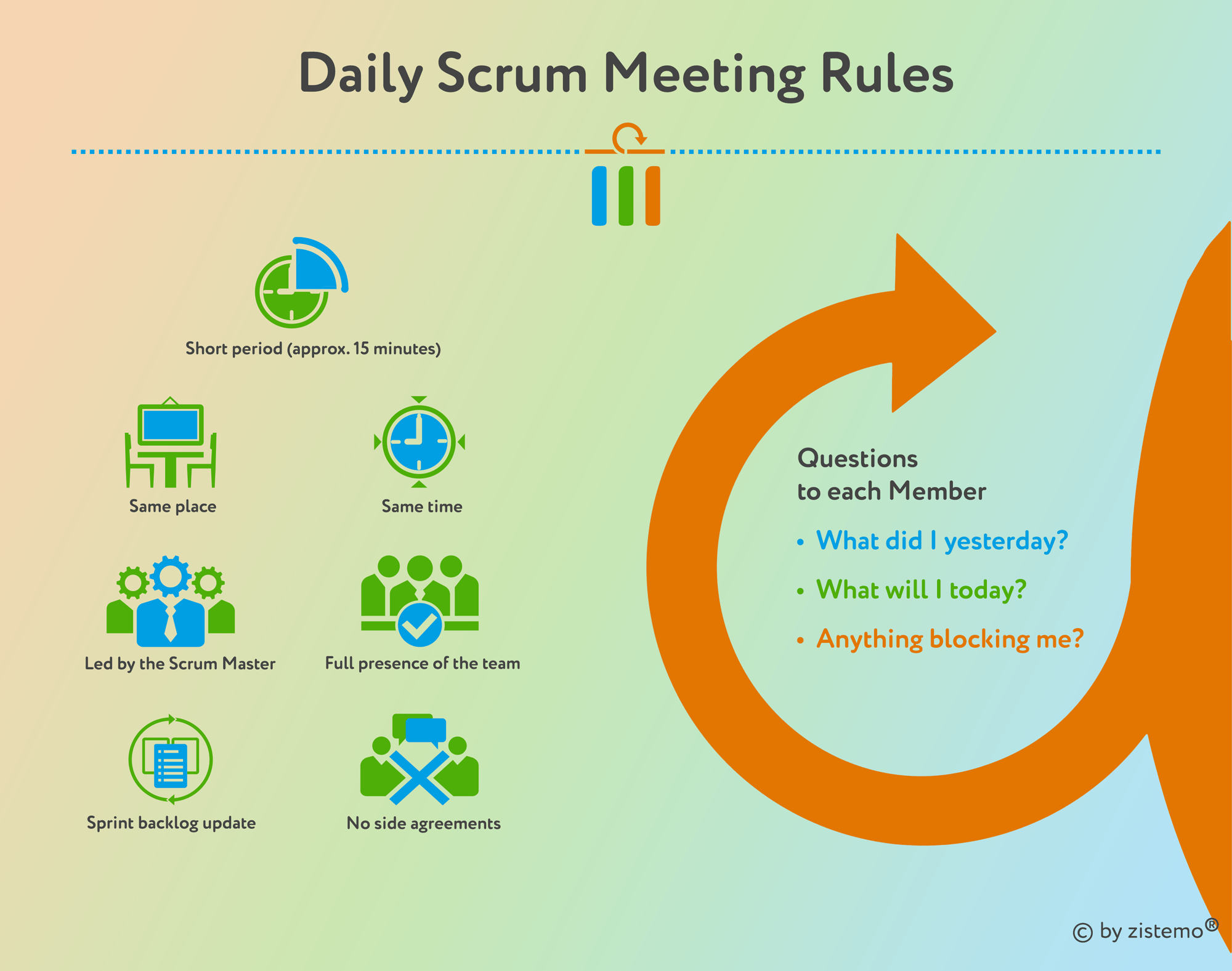
zistemo: Mastering the Daily Scrum Meeting Rules.
Differences between traditional waterfall project management and Scrum methodologies
In the world of project management, two predominant methodologies have emerged: traditional waterfall and Scrum. Both have their supporters and detractors, but the key difference lies in their approach. Traditional waterfall follows a linear, step-by-step process, where each phase must be completed before moving on to the next. Scrum, on the other hand, is an iterative and incremental processes, approach that emphasizes collaboration and flexibility.
At Zistemo, we understand the importance of choosing the right project management methodology for your team and your project’s unique needs. By opting for Scrum, your team can benefit from increased efficiency, better communication, and greater adaptability to changing requirements.
So, which methodology is right for you? It all depends on the goals, resources, and priorities of your project.
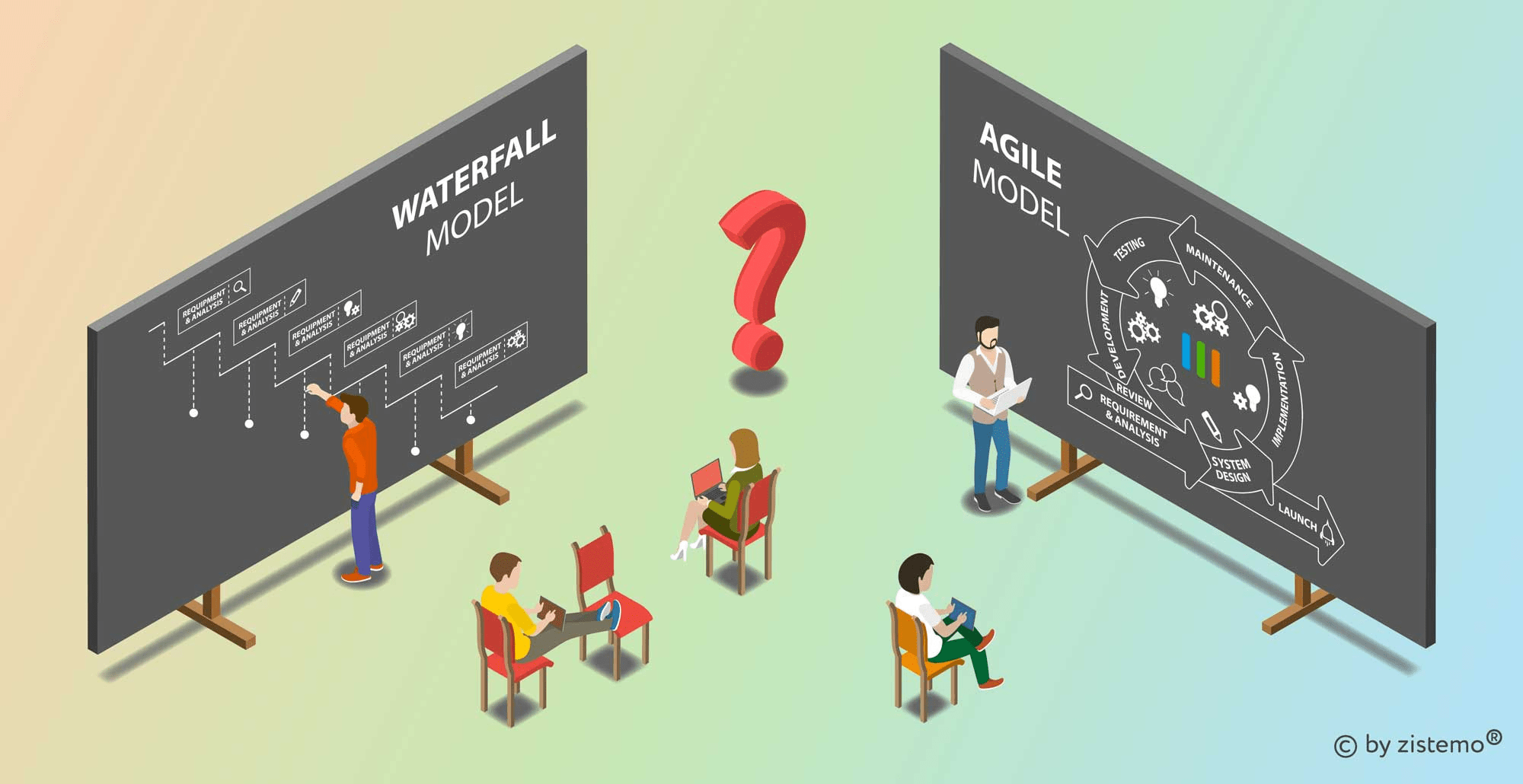
zistemo: the differences between traditional waterfall projects vs. scrum methods and highlights their different approaches.
Tips for implementing agile scrum techniques on your next project
Agile scrum techniques are an effective project management methodology that emphasizes incremental progress, continuous feedback, and collaboration. If you’re planning to implement agile scrum techniques on your next project, there are a few critical tips that you should consider.
- Firstly, ensure that you have a clear understanding of the project goals, timelines, and deliverables.
- Secondly, prioritize the most critical tasks and break them down into smaller manageable chunks.
- Thirdly, foster a culture of transparency, communication, and open dialogue among your team members.
- Finally, leverage accessible project management methodology such as zistemo to streamline communication, documentation, and tracking progress.
By following these tips, you can successfully implement agile and scrumming project management techniques on your next project and achieve better results.

zistemo empowers scrum teams to work efficiently and effectively.
How does task prioritization in Scrum work?
Task prioritization is an essential aspect of any project. It involves deciding which tasks are most important and need to be worked on first. There are several methods you can use to prioritize your tasks, but two prominent ones include the product backlog and sprint planning meeting.
The product backlog can be described as a list of features or enhancements that need to be developed, so working on the most important ones first is crucial. Sprint planning meeting, on the other hand, gives you an opportunity to plan what tasks need to be completed during each sprint, allowing you to prioritize them based on their importance.
Zistemo is one tool that can assist you in prioritizing your tasks by automating the process and ensuring that nothing is overlooked. Ultimately, prioritizing tasks is all about being organized and efficient so that you can achieve your objectives.
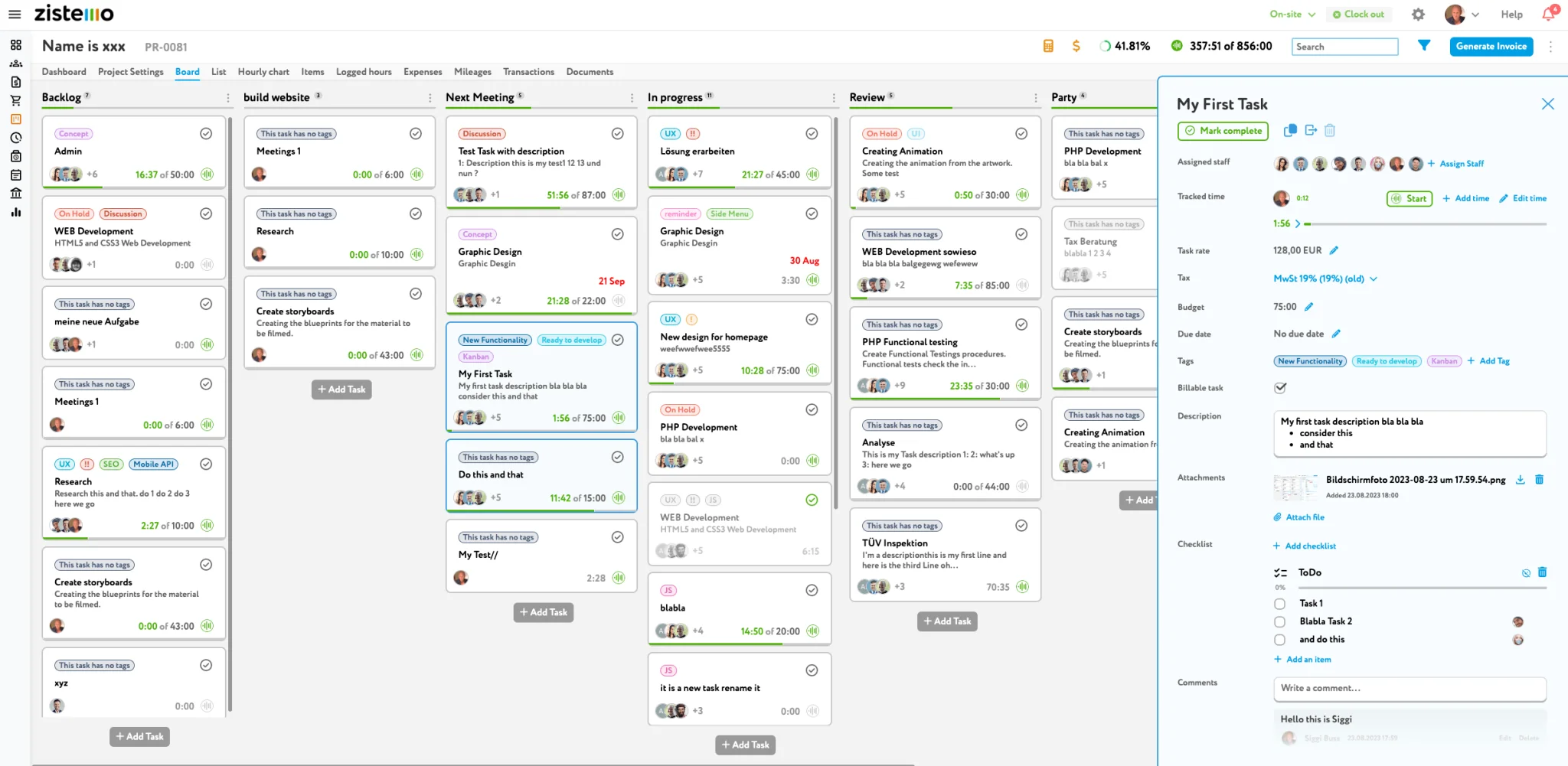
Zistemo scrum board
What are Scrum ceremonies?
Scrum ceremonies, also known as Scrum events, are structured activities in the Scrum framework designed to ensure regular synchronization, inspection, and adaptation of the product, the work, and the team’s performance. Srum ceremonies consist of four key events: the Sprint Planning Meeting, the Daily Stand-Up, the Sprint Review, and the Sprint Retrospective. These ceremonies play a crucial role in ensuring effective collaboration and continuous improvement within a Scrum framework.
Sprint Planning Meeting is a meeting in which the team decides the work they will complete in the upcoming sprint.
Daily Scrum is a brief, daily meeting where the development team discusses progress and plans for the day ahead.
Sprint Review occurs at the end of the sprint, where the team shows what they’ve accomplished during the sprint.
Sprint Retrospective is where the team reflects on the past sprint and plans for improvements in the next sprint.
These ceremonies are a crucial part of effective Scrum implementation and enable the team to manage work efficiently and continuously improve.
Frequently Asked Questions about Scrum Project Management
What is Scrum?
Scrum, an Agile project management framework, prioritizes flexibility, collaboration, and customer satisfaction. It fosters a harmonious balance between adaptability and team engagement, resulting in delighted customers. It breaks down projects into small, manageable pieces called sprints, each of which is a time-boxed iteration of work.
Who is involved in a Scrum team?
A Scrum team typically consists of a Product Owner, Scrum Master, and Development Team. The Owner represents the customer’s interests, the Scrum Master facilitates the process, and the Development Team does the actual work.
What is a Scrum sprint?
A sprint in Scrum is a set period during which specific work must be completed and made ready for review. Sprints typically last one to four weeks. In terms of delivery, a Scrum team delivers work in increments through time-boxed periods known as sprints.
What is the role of Scrum Masters?
The Scrum Master serves as the team’s coach, guiding them through the Scrum framework, removing obstacles, and ensuring clear communication among all team members and stakeholders.
Why is a certified Scrum Master important?
A certified Scrum Master manages the Scrum process, has primary responsibility for ensuring its correct and effective implementation, and plays a central role in fostering a productive and collaborative team environment.
How does Scrum differ from traditional project management?
Unlike traditional project management, which is linear and sequential, Scrum is iterative and incremental. This allows for greater flexibility and the ability to adapt to changes quickly.
Can Scrum be used for non-software projects?
Yes, while Scrum originated in the software development industry, its principles and methodologies can be applied to any project that requires incremental development and ongoing feedback.
How do I get started with Scrum?
To get started with Scrum, you need to understand its principles and methodologies, assemble a dedicated team, and adopt a Scrum-friendly mindset and culture.
Utilizing key scrum tools like zistemo can also aid in your Scrum journey.
What is a sprint backlog?
A sprint backlog is a list of tasks that the team commits to complete in a particular sprint. It’s derived from the product backlog, and it’s considered flexible during the sprint as the team learns more about the work needed.
What is a sprint review?
A sprint review is a meeting held at the end of each sprint cycle where the Scrum team and stakeholders discuss what was accomplished during the sprint and what needs to be done next.
It’s an opportunity for the team to demonstrate the work they’ve completed, gather feedback, and adjust the product backlog if necessary.
What does next sprint mean?
In Scrum, once a sprint is completed, the team immediately starts the next one. The next sprint begins with planning, center stage where the team determines the work to be tackled in the upcoming sprint.
What is a sprint goal?
The sprint goal is a short, concise statement that describes what the team plans to achieve in the sprint goal itself. It provides a shared objective, and is decided upon during planning session.
The sprint goal process incorporates both the Sprint Review, an opportunity for feedback and adaptation regarding the product, and the Sprint Retrospective, a chance for the team to reflect and improve upon their own processes.
What is a Daily Scrum Meeting?
Daily Scrum Meetings is a short daily stand-up meeting, ideally taking place every day at the same time. The Development Team discusses work progress and plan the work for the next 24 hours. This meeting is crucial for promoting transparency and synchronization among team members.
What are Agile Methods?
Agile methods, highly valued in the Agile community, refer to a group of software development and processes, including Scrum, that value adaptability and small, incremental changes.
These methods prioritize customer satisfaction by delivering functional software frequently, encouraging collaboration between the development team and stakeholders, and enabling teams to respond to changes in customer requirements.
How does the Daily Scrum contribute to a whole project manager’s success?
It’s allows for quick identification and resolution of obstacles. It promotes transparency and ensures that every team member is on the same page regarding project progress and goals, which improves coordination and efficiency.
What is the collective responsibility of the Product Owner during Sprint Planning?
During Sprint Planning, the Product Owner communicates the objectives that small team led the sprint should achieve. They also work with the team to select the backlog items that will best achieve those sprint goals.
How do Agile methods benefit project management?
Agile methods allow for quick response to changes, improved communication, better product quality, and higher customer satisfaction. They also promote regular reflection and adaptation, enabling continuous improvement in both the product and the working environment.
What is the Scrum Guide?
The Scrum Guide is the definitive rulebook for Scrum. First written in 2010 by Ken Schwaber and Jeff Sutherland, the creators of Scrum, the Guide provides the definition of Scrum, outlines its scrum methodology, roles, events, artifacts, and their associated rules. The guide is regularly updated to reflect the evolution of the Scrum framework.
Who works a Scrum process?
The development process is worked by a Scrum Team, which consists of a Product Owner, Scrum Master, and the Development Team.
The Product Owner manages the product backlog and maximizes value, the product owner or Scrum Master facilitates the process, and the Development Team creates the product increment.
What is a timebox in Scrum?
A timebox in Scrum is a defined period during which a specific activity or process should be completed. Each event in Scrum—such as the Sprint, Daily Scrum, Sprint Planning, Sprint Review, and Sprint Retrospective—is timeboxed, meaning they have a maximum duration. This ensures that the team remains focused and on schedule.
What is a Scrum board?
A Scrum board is a visual management tool used to track the progress of work and to manage work in progress (WIP). It visualizes the flow of tasks from the initial stages to completion. A basic, scrum master board consists of three columns: “To Do”, “In Progress”, and “Done”, but can be customized based on the team’s needs.
What are Scrum artifacts?
Scrum artifacts are key elements used to track and plan work throughout the process. They include the Product Backlog, which lists all desired product features; the Sprint Backlog, which contains items selected for the current sprint; and the Product Increment, which is the sum of all completed backlog items.
What is a Scrum role?
In Scrum, there are three primary roles: the Product Owner, Scrum Master, and Development Team. The Product Owner manages the product backlog and prioritizes work based on value.
The scrum master product owner or Scrum Master facilitates the Scrum process and helps the team remain productive. The Development Team is primarily responsible for delivering potentially shippable product increments at the end of each sprint.
What is backlog refinement?
Backlog refinement, also known as backlog grooming, is the process of updating the product backlog. This typically involves adding detail, estimates, and order to items in the Product Backlog. Backlog refinement is a continuous process that helps ensure the team has ready items to work on for the next sprint.
Conclusion:
The Scrum methodology, which has its origins in the metaphor of rugby scrum, is a powerful, cross-functional approach to project management that is described in the definitive Scrum guide. The scrum team, which consists of a product owner, a scrum master and a scrum development team together, works to create product increments in set timeframes.
Agile working and agility are the key principles in this framework, with a focus on flexibility, efficiency and rapid adaptation to change. Scrum uses various artifacts such as the product backlog, sprint backlog and product increment to track and plan work.
Key processes include defining “done”, setting criteria for completing work and refining the backlog to ensure readiness for the next sprint. A Kanban board is essential for visually managing the workflow. Design thinking fits well with agile methods as it encourages a problem-solving approach that focuses on user needs and iterative learning.
Getting started with Scrum may seem daunting at first, but once you understand the principles and methods, you can significantly improve your agile project management skills.
The strength of Scrum lies in its simplicity, its adaptability and its commitment to delivering high-quality products in a timely manner.
Remember that Scrum is not just about following a set of rules, but a mindset and culture that encourages teamwork, continuous learning and improvement.
Don’t be afraid to ask questions, make mistakes and learn from them. Your journey with Scrum is sure to be a fulfilling one and open up numerous opportunities and career moves.
References:
To gain more insights and in-depth understanding of the topics discussed in this document, you can refer to these additional resources on Wikipedia:
- Scrum :) This page provides comprehensive knowledge about the Scrum framework, its roles, artifacts, and practices in a software development context.
- Project Management: This page offers an overview of project management, its approaches, and the different methodologies used, including both Agile and Waterfall.
- Waterfall Model: This page details the Waterfall project management technique, its history, and its applications.




